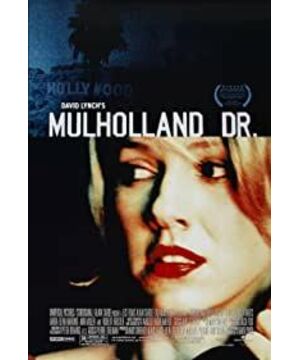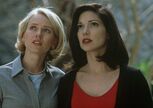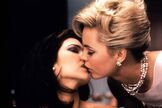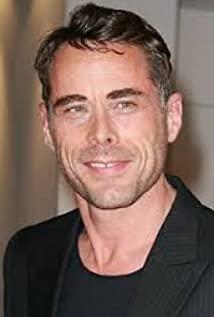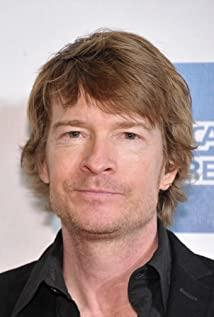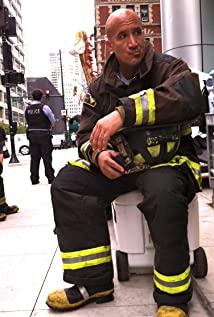An understandable cause is hidden behind the chaotic dream.
2016.2.17 was revised to a graphic version.
Look finish "Mulholland Drive", gasp! As many people have pointed out, the first 3/4 of the plot of the film is actually a dream, and I did not expect anyone to show the nightmare in images with such precision in emotion and atmosphere. The nightmare of others may be more than the nightmare of myself. horrible.
Presumably director David Lynch has a deep understanding of Freud's "Analysis of Dreams", otherwise it would be impossible to conceive such a nightmare. The reason for saying this is because when I tried to analyze this seemingly absurd nightmare using Freud’s dream interpretation method, I found that I could parse a self-consistent logical chain from it. The seemingly chaotic dreams are actually behind There are reasons that can be understood.
Next, I will try to use Freud's dream interpretation method to analyze the nightmare of "Muholland Road". Freud's dream interpretation theory is related to this film, mainly as follows:
1. Freud believed: Dream is the satisfaction of wish. The analytical formula of dream is: dream = suppressed desire + disguised satisfaction. In other words, dreams are always used to express a certain wish of the dream master. It's just that even in a dream, in order to avoid certain concerns of the dreamer's consciousness, the expression of wishes is not straightforward, but is disguised as such a clear look.
2. Simulate the same effect: Simply put, it means substituting yourself into another person in a dream . This is mostly because we subconsciously lie to ourselves "it's not me" in order to avoid some pressure, and let another person release the pressure and realize our wishes on our behalf. (This appears many times in the dreams in the film.)
Let me first disrupt the narrative sequence of the film to explain the background of this nightmare in the film, which is the real part of the film.
The real part of the story
Diane was raised in Ontario, Canada under the support of her uncle and aunt who was an actor. Probably under the influence of her aunt, she has always hoped that she can become an actor and make her way in Hollywood. She won the first prize in a jitterbug dance competition, made her mark, and has since entered the showbiz.
After the death of her uncle and aunt, she came to Hollywood alone. Like many other girls who come to Hollywood to find their dreams, she rented a simple house, participated in the audition, and waited for one day to be selected by a director and become famous in one fell swoop.
Soon, a movie called "Silvia North Story" was selected for the heroine. Diane went to the audition, but failed. A girl named Camilla conquered the production team with her nearly perfect performance during the audition, got the role, and became famous in one fell swoop. Diane and Camilla met and became good friends. With the help of Camilla, Diane played small roles in some of the films she starred in.
During this time, Camilla has become the darling of film companies, and Diane and Camilla have become gay partners.
In order to conceal others, Camilla often wears a golden wig to Diane's house for a tryst with Diane. Camilla doesn't seem to care about their relationship, but Diane regards Camilla as her lover.
Later, there was a big production movie soliciting the heroine. On the set, director Adam and Camilla fell in love at first sight, and Camilla naturally became the heroine and Adam's girlfriend.
Diane still plays a small role in the film. But Diane, who is in love with Camilla, cannot accept Camilla's empathy. After witnessing Camilla flirting with Adam on set, Diane and Camilla had a big quarrel.
Desperate Diane was crying and masturbating at home. The phone rang, it was Camilla. Camilla sent a car to pick up Diane to Mulholland Road, where Hollywood dignitaries live. The car suddenly stopped on Mulholland Road. Diane was a little scared. She asked the driver, "What are you going to do? We shouldn't stop here!" The driver turned around and said, "I will give you a surprise."
Camilla appeared by the car, and she took Diane across a mountain road to a mansion. It turns out that this is Adam's home. A party is being held, and many people from the film company and crew are there. After Diane exchanged greetings with Adam's mother Coco, the banquet began. At the party, Diane continued to endure Camilla flirting with Adam. At this moment, an actress came over to talk to Camilla in a few whispers, and kissed Diane in front of her.
Diane felt desperate. She knew that even Camilla's same-sex girlfriend's status had been replaced. Later, when Adam said, "Camilla and I are about to (marry)", Diane finally couldn't bear it.
From jealousy to hatred, Diane went to a dead end. She hired a killer in a fast food restaurant and asked him to kill Camilla. The killer gave her a blue key, so that she could get something that would prove Camilla's death from a homeless man.
Diane came to the tramp, who threw a blue box to her, which seemed to be able to open with the blue key.
Is there the remains of Camilla inside? ! Diane began to collapse, she seemed to see her uncle and aunt running out of the box. She ran back home in fright, fell on the bed exhausted, and had a nightmare (this nightmare made up the first 3/4 of the film).
After waking up, Diane stared at the blue key on the coffee table. Thinking of what she had done, she completely broke down, and she saw her uncle and aunt chasing after herself fiercely. She fled to the bed, took out a pistol, and committed suicide.
To the reality that is part of the story, it is the dreamer of this dream Diane background. Let's analyze dreams below. This dream is complicated because the names, identities, and experiences of many people in the dream are completely different from reality. The character and experience of A in dreams may belong to B in reality. Therefore, before analyzing this dream, I will compare the identities of the main characters in the dream and reality.
Reality/Dream Character Comparison Table
Diane/Betty
In reality: the heroine of the film as mentioned earlier
In dreams: Betty (Diane's incarnation, ideal and perfect Diane, but sometimes the incarnation of Camilla in reality)
---
Camilla/Rita
In reality: Camilla as mentioned before
In the dream: Rita ---
Diane's aunt/stranger at the airport
In reality: Diane's aunt and parents (deceased)
Dreamland: The stranger Betty met on the plane. In the dream, Betty's aunt (the one who left her house) is Diane's idealized aunt. ---
Adam
In reality: director
Dreamland: Director
---
Coco/Adam mother
In reality: Adam's mother
Dreamland: Betty’s landlord
---
Adam's wife and her lover
In reality: Adam's wife and her lover
In the dream: Adam's wife and her lover (their image should be fictitious)
---
The blonde woman kissing Camilla/Camilla
In reality: may be one of the actresses in the crew.
In the dream: The name in the dream is Camilla! It was the black forces behind the film company that forced Adam to choose the heroine.
---
Coffee spitting man/party participant
In reality: I showed up at a party, maybe a member of the crew.
In the dream: A member of the dark forces behind the film company, once threatened Adam to choose the Camilla they recommended as the heroine.
---
Old man with white beard/silent theater performer
In reality: one of the performers in Silent Theater
Dreamland: The owner of the hotel where Adam was in trouble
---
Cowboy/Party Participant
In reality: Appeared at a party, may be an actor
In the dream: the thugs behind the movie company, once threatened Adam
---
Waitress
In reality: the waitress in the fast food restaurant, named Betty (this is the source of Diane's name in the dream)
In the dream: the waitress in the fast food restaurant named Diane (the name of the waiter in the dream became a clue for Rita to track her own identity)
---
"Passerby"/Café customer
In reality: a customer of a fast-food restaurant, Diane had a relationship with him when he was dealing with a killer in a fast-food restaurant.
In dreams: He sought help from a psychologist in a fast-food restaurant because he dreamed of the tramp.
---
Tramp/Devil Behind the Wall
In reality: the person who gave Diane the blue box instead of the killer
In Dreamland: The Devil Behind the Wall
---
The above is the comparison table of the main characters in the film in reality and dreams. Below, I will try to interpret this dream in the film in the order of the plot.
Movie opening piece of the picture a few dancing couple dancing in a virtual blue foreground, their images are copied into a lot of copies. At this moment Diane's image appeared, her face filled with excitement. In the next video, Diane and her uncle and aunt cuddled up and appeared.
This passage tells Diane's life experience: 1. She was raised by her uncle and aunt; 2. She won a jitterbug dance competition and entered the show business since then (this experience was later revealed by Diane herself at Adam's party.)
The first two shots was Diane's first lens perspective, accompanied by her heavy breathing. At this time, he had just escaped home from the tramp. The bed, sheets, and pillows swayed before her eyes. Then the camera faded out, and Diane was actually starting to dream. (The cunning David Lynch, in fact, he has already told the audience here that the next plot is a dream, but when watching the film for the first time, how many audiences can understand the meaning of this scene?)
Dream territory starting from the third lens (described below with reference to the cutscene Zhou Liming teacher in the "movie" introduction "Mulholland Drive," the text on the magazine; To take into account the discussion of logic, order and shot the movie mentioned below slightly There are discrepancies):
Dreamland Scene One: Car Accident
The camera fades in, showing the road sign of "Mulholland DR." Camilla).
The car stopped suddenly, and Camilla asked the same question as Diane in reality: "What are you going to do? We shouldn't stop here!" The driver took out a pistol at her and ordered her to get out of the car.
At this time, a sports car full of racing cars drove oncomingly and collided with Camilla's car. Everyone was killed, except Camilla. She staggered down the mountain and hid in an apartment where the hostess was about to go out (aunt Betty's apartment). Two police detectives started investigating at the scene of the accident.
After learning about the car accident, the dark forces behind the film company that had planned to kill Camilla exchanged phone calls and confirmed that Camilla was missing. And the last one that rang was the phone in Diane's house in reality.
Analysis 1
What are Diane's strongest emotions and desires before going to bed?
I think it is regret and guilt. She hoped that Camilla hadn't died yet, so the scene where Camilla had escaped the catastrophe first appeared in her dream.
But there is another demon at work, and Diane is afraid to admit that she hired a killer to kill Camilla. She hoped it wasn't herself who killed Camilla. So in the dream, those who wanted to kill Camilla became the dark forces behind the film company.
This consciousness of Diane has been continued in the dream, and has developed another main line of the dream based on this-the encounter of director Adam and the storm of film casting. Of course, that main line also has other meanings.
Analysis 2
In reality, after Camilla's disappearance, the film company and the police have been tracking her whereabouts and pointed the finger at Diane. This can be seen in Diane's subsequent conversation with her friend-the two detectives have been looking for her for questioning. Presumably the film company has been calling her too. Therefore, images of police detectives and film company personnel also appeared in this dream.
Dreamland Second Act: Airport
Betty came to Hollywood from Ontario, Canada, and said goodbye to an old couple she met on the plane at the airport. The old couple (especially the old woman) expressed their heartfelt blessings to Betty. Then Betty took a taxi to the apartment her aunt left her.
Analysis 1
In the dream, Diane changed her name to Betty, which came from the name of the waitress Diane saw in the fast-food restaurant (the elements in the dream are often from the images seen the day before the dream).
Betty in the dream looks bright, optimistic, and confident, which is very different from the real image of Diane in reality, which is decadent, down and inferior. Betty is actually the idealized image that Diane hopes to be in her heart. She escaped from her true self in the dream, so she simply changed her name, "If I were Betty, and everything started again, that would be great!"
Analysis 2
The image of the old couple is actually Diane's uncle and aunt. Not dare to face her uncle and aunt, who was kind to herself and cherished hope, which was an important reason for Diane's suicide in the end.
But in the dream, the uncle and aunt were changed into strangers. The reason is that Diane tried to alleviate her guilt in her dream-if it is only a stranger who is full of hope for herself, then the guilt is not so great that it is unbearable.
The last shot of this passage is the old couple sitting in the car, their faces are filled with the typical happy smiles full of hope for their children. But the background music of this scene is very strange, which is exactly how Diane feels ashamed to portray her uncle and aunt.
Dreamland Act Three: The Devil
In the fast-food restaurant, two men were talking. One of them was the man Diane had met during a deal with the killer (call him "Passerby" for now), and the other seemed to be a psychologist. Passerby said he saw the devil behind the wall behind the restaurant. When they walked out of the store, a devil appeared on the wall—the homeless man who handed the blue box to Diane in reality.
analyze
In reality, the tramp is the one who gave Diane the blue box instead of the killer, and is a witness to Diane's crimes. Deep down in Diane's heart, she was terrified of seeing this person. So in the dream, Diane replaced herself with a passerby who didn't know her crime. Put yourself in the shell of the passerby to indirectly vent your fear of homeless people (that is, the imitation in Freud's theory).
Dreamland Fourth Act: The Unlucky Director
Director Adam is looking for a heroine for a major production of his film, but the dark forces behind the production company sent someone to send a photo of Camilla, a blonde woman, to force Adam to choose her as the heroine.
Adam left angrily. When he returned home, he found that his wife and the cleaner were fooling around. Adam ruined his wife's jewelry in a fit of anger, but was beaten up by his wife's lover and kicked out of the house.
Analysis 1
Adam is the key person who caused Camilla to leave Diane. In addition to the hatred of Camilla for leaving her in Diane's consciousness, of course there was also the hatred of love for Adam. So she retaliated against Adam fiercely in her dream: He was coerced by the company, cuckolded, and swept out again.
Adam did have a divorce in reality. He mentioned at the party: He got the pool, and his ex-wife got the pool cleaner. But because of Adam's character, he should not mention to others his disgraceful experience of being repaired by his wife and cleaner. Therefore, the plot of Adam being beaten and the image of Adam's wife and her lover should be made up by Diane. (2) The significance of the very critical "casting storm" and why Camilla was replaced by a blonde woman, will be analyzed after the whole dream has appeared in its entirety.
Analysis 2
As for the significance of the very critical "casting storm" and why Camilla was replaced with a blonde woman, we will analyze it after the whole dream is fully presented.
Dreamland Act 5: Crappy Killer
The killer appeared: He killed a long-haired man and accidentally hit the female secretary. Finally, he killed the female secretary. He was discovered by the cleaner, killed the cleaner, and accidentally hit the vacuum cleaner, making the alarm bell sound. .
analyze
Diane knew that Camilla had been killed by the killer in reality-will this be discovered? This strong doubt and fear is manifested in the dream as a killer who wants to cover up after killing a person and repeatedly fails. The more he tries to cover up the fact of the murder, the more self-defeating.
Dreamland Scene 6: The Landlord’s Wife
Betty came to the apartment left to her by her aunt. The landlord Coco came to welcome her. The apartment was luxurious and comfortable. Betty was very satisfied.
Analysis 1
Diane's aunt used to be a Hollywood actor, then went to Canada, and then passed away. This is what Diane said at Adam's party. And in the dream, she made up an idealized aunt-a relationship in Hollywood (in the latter dream, the person in charge of Betty's audition was a friend of her aunt), and she also left a pretty good place to live for her. This constitutes a sharp contrast with reality: in reality, Diane is actually very lonely and helpless. She came to Hollywood alone and can only afford to live in a simple house.
Analysis 2
The image of the landlord Coco comes from Adam's mother in reality. At the party, Diane had a simple conversation with Coco, and Coco had a little sympathy for Diane's encounter, but when Adam said, "I and Camilla are going to (marry)", Coco showed a hint of disdain. This little sympathy and understanding of Coco made Diane turn Coco into a very enthusiastic landlord wife in her dream.
Dreamland Act Seven: Rita
Betty spotted Camilla hiding in the apartment. Camilla lost her memory in a car accident and forgot her name and identity. She called herself Rita by the Hollywood star Rita Hayworth (Rita Hayworth) on the apartment poster. After Betty heard what happened to Rita, she decided to help her find out the truth. They found a large amount of cash and a blue key in Rita's handbag.
Analysis 1
Camilla's images in reality and dreams are exactly the opposite. In reality, Camilla is glamorous and lofty. In the dream, she was helpless and melancholy, which is exactly the temperament of Diane in reality. Diane hopes that she (Betty) will be strong, and Rita who is weak must rely on herself to survive.
Let Camilla stay by her side forever-this is one of Diane's strongest wishes. Therefore, in the dream, Camilla has amnesia and can only be attached to Betty. The personality, attachment relationship and destiny of the two in reality and dream are reversed.
Analysis 2
The image of money comes from the money Diane paid the killer. In reality, Diane only used a stack of banknotes to hire a killer, but in his dream Rita's handbag had far more money than this. Perhaps a very hidden wish in Diane's subconscious mind is to hope that even if Camilla is dead, she will not die from the cheap killer she hired, but should die more "valuable"!
Analysis 3
This blue key is the key used in reality to open the blue box containing something that proves that Camilla is dead. This is the biggest projection of anxiety in Diane's mind.
Dreamland Act 8: Hotel
Director Adam lives in a cheap hotel, and the hotel owner tells him that his bank account has been blocked. Then Adam was threatened by a mysterious cowboy. This cowboy was obviously a thug behind the movie company.
analyze
The continuation of the "casting storm".
Dreamland Act Nine: Audition
Betty is going to audition, she will talk to Rita at home first. At the audition the next day, she conquered everyone with a perfect performance.
She was taken to the set, ready to meet director Adam. At this time, Camilla, the blonde woman recommended by the movie company, was also auditioning. Adam reluctantly compromised. He said, "This is the girl I'm looking for."
But he noticed Betty behind him. The moment they made eye contact, both of them seemed to be electrocuted. But Betty fled the set very inexplicably because he wanted to help Rita.
Analysis 1
This is a critical dream. As mentioned earlier, in the dream, the identities and experiences of Diane and Camilla are interchangeable. In addition to the ideal image of Diane, Betty in the dream also has a lot of the temperament and experience of Camilla in reality.
And this dream happened in reality, but it was not Diane who successfully auditioned, but Camilla. Here, Betty's identity has become more of the incarnation of Camilla in reality. (Diane has imitated herself as Camilla. Of course, Diane hopes that she will be successful in the audition like Camilla, and she will become so prosperous.)
In reality, it was Camilla who fell in love with Adam at first sight on the set. Adam's phrase "This is the girl I'm looking for" really said to Camilla in reality. But how much Diane wished that this scene had not happened, how much she wished that Adam had chosen not Camilla but other girls, so that Camilla would stay with her forever.
Therefore, in her dream, she made up a "casting storm" in which Adam selected a girl who had nothing to do with her under the control of the dark forces behind the film company. In the dream, Adam chose a blonde Camilla who didn't know him at all, not his own black-haired Camilla (Rita). This is the fulfillment of Diane's wish of " If Adam didn't choose Camilla when auditioning " was disguised. This is the significance of the casting controversy and the reason why Camilla in the dream was replaced by a blonde woman she did not know each other.
Then, when Adam and Betty fell in love at first sight, Diane actually understood that in reality this was the beginning of Camilla and her parting ways. Her subconscious refused to continue their development, so Betty left the set inexplicably.
Analysis 2
In fact, there have been two castings in reality. The first time was "Silvia North Story" by director Bob Broker (the director who auditioned for Betty in his dream). Camilla and Diane both went to auditions, and they met at that time. Camilla got that role and became famous. The last time was an audition for Adam's film. Dreams have a condensed effect. Here, Diane condenses these two experiences together.
Dreamland Act 10: Female Corpse
Rita saw "Diane" on the nameplate of the waitress in the fast food restaurant, and she remembered that her real name might be Diane.
So Betty and Rita found the apartment where Diane lived together, and found a female corpse that had rotted on the bed.
analyze
Diane's deepest fear finally appeared in her dream! That apartment is indeed the apartment where Diane lives in reality, and the carrion—black pajamas, black curly hair on a shawl—that really looks like Camilla in reality! This is actually the death of Camilla that Diane imagined. In the dream, her death was linked to the name Diane.
" Camilla has been killed by Diane! " Diane's consciousness was projected into this dream.
Dreamland Act 11: Blond Woman
When they approached Diane's apartment, they saw several men who looked like bodyguards. One of them also picked up a blonde woman. Because of inexplicable fear, they avoided these people.
analyze
In reality, Camilla is already at least a slightly famous star, and seems to be the darling of film companies. Therefore, when she came to Diane's house, she always wore a golden wig to cover her eyes and was accompanied by a bodyguard. This is the source of the image of a bodyguard and a blonde woman.
Dreamland Act 12: Blond Rita
Betty and Rita fled home, and Rita felt that he would also suffer the doom of death. Betty helped her put on a blonde wig. Betty invited Rita to sleep in the same bed. The two had sex and expressed their love to each other.
Analysis 1
Rita finally put on a golden wig, which should be the image of Camilla every time he appears in Diane's house in reality. Only when Camilla wears blond hair does she belong to Diane completely.
Analysis 2
The wish of "Let Camilla return to her side" finally came true in her dream. But Diane's subconscious still knows that Camilla is no longer there, so the soundtrack of this episode has a taste of life and death.
Dreamland Act 13: Silent Theater
Rita kept calling the word "silence" in Spanish in her dream. Betty woke her up. They came to a theater called "Silent" to watch the performance. The theme of the performance is "All you see and hear are illusions, phantoms ". Betty kept sobbing and even trembling violently in the audience. Rita found the blue box in her bag.
analyze
This nightmare is almost over!
The "Silent" theater is actually the place where Diane and Camilla have been in reality. This can be inferred from the "Old White Beard", an actor in the "Silent" Theater. In the previous dream, he was the owner of the hotel where Adam lived when he was in trouble. The actor in the "Silent" theater is his true identity.
The theme of the theater performance is to expose illusions, which corresponds exactly to: dreams are illusory, and cruel reality is about to come . So Betty (Diane), who realized this, kept twitching. At the same time, the blue box representing Diane's crimes in reality also appeared, and everything became more and more "real".
The "Silent" theater appeared near the end of this dream due to the particularity of its theme, and became the point where dreams and reality were combined.
Dreamland Act Fourteen: The Blue Box
When they returned home, Rita took out the blue key. At this time, Betty was gone. Rita opened the blue box alone, and the camera entered the box, and it was dark.
analyze
The dream is coming to an end. Betty is gone. At this time, Rita is almost completely the incarnation of Diane. It seems that only Rita (in fact, Diane herself) is left in the world, who is helplessly and fearlessly bearing the sins she committed (blue box).
Dreamland Act 15: Ending
The end of the dream: Betty's aunt looked around her apartment and left. The camera suddenly shifted to Diane's apartment, and the one who slept on the bed was what the dead body in Diane's apartment looked like in his dream. The cowboy opened the door and said, "Beauty, it's time to get up!"
The camera turns back to the bed, and the body has decomposed. The nightmare is over.
In the next shot, Diane lies on the bed in the same sleeping position as the corpse. The friend she had changed rooms with came to fetch things, and her knock on the door woke Diane up.
analyze
At this moment Diane was already half-dreaming and half-awake. "Beauty, it's time to get up" Is it something someone said to Diane before? Is it a cowboy? The cowboy has only appeared in Adam's party once in reality, and he has never shown his face. If it's the cowboy, is it Diane's lover? A more reasonable guess might be: Diane and Camilla often said this sentence before, or it was just said by the friend who knocked on the door, but why did the speaker's image in the dream become a cowboy? Cowboy is really a difficult role to understand.
To on is my interpretation of "Mulholland Drive" this nightmare. I myself occasionally have nightmares, and almost none can leave an impression for a long time, and the nightmare presented to me by David Lynch may stay with me for a long time. Feeling the same with other people’s dreams, this peculiar experience may only be felt by those of us who have watched Mulholland Road.
Plot analysis: Black fool, Wei Zhichao, who was also called "Crazy Diamond" at the time
Text: Wei Zhichao
About this film review
In 2001, David Lynch's "Mulholland Road" began to circulate in China because of its popularity among film critics. At that time, I was still an undergraduate in applied chemistry. After watching the film with my roommate, I analyzed its structure and found that none of the film reviews we had really understood the content of the film. Film critics feel the artistic value of this work with their very keen artistic sense, but they may not really understand it.
I am a die-hard rationalist, and feel that before I begin to express my feelings for a movie, I should first understand what its story is about. So in the next few days of class, I drove the whole process, using the little Freud's knowledge of dream interpretation after reading free books and learning to disassemble "Muholland Road" and wrote this article. Because of this article, I was mistaken by many people for studying psychology, and some people thought that I was a film critic. In fact, I was completely amateur at the time. "The full analysis of the story of "Mulholland Road"" was first posted on the NetEase Entertainment Forum and later spread across the Internet. My fate with psychology and film critics all originated here.
Unexpectedly, after graduating from undergraduate, I really switched to studying psychology. After entering the industry, I have learned more and more about psychology, and at the same time, I have learned more and more deeply how deeply I misunderstood psychology in the past. For example, the dream interpretation ideas mentioned in this film review are no longer mainstream in the field of scientific psychology today. The reason is that Freud’s theories seem to be profound, but they are not derived using scientific methods. If you check it, you will find that there are not many conclusions that hold up (a few of his big ideas have been abstractly inherited).
Artists love Freud, and David Lynch is the best example. He almost completely structured the plot of Mulholland Road according to The Analysis of Dreams. But I still have to say that Freud was a great thinker, but not a qualified scientist.
A little bit of private goods, my new book published in 2020:
View more about Mulholland Drive reviews


